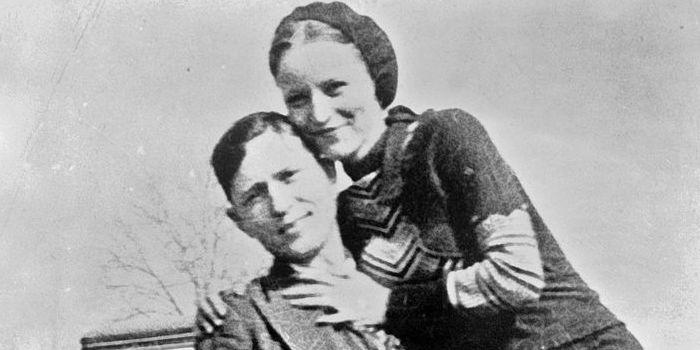10 Surprising Things You Didn't Know About Bonnie and Clyde

Dying young in a hail of bullets in 1934, Bonnie Parker and Clyde Barrow are legendary for their youthful Robin Hood personas as they robbed their way across the United States during the Great Depression. The two were reintroduced to a new generation in Arthur Penn’s 1967 film Bonnie and Clyde, played by Warren Beatty and Faye Dunaway. The movie portrayed the felonious pair as counterculture anti-heroes-a perception that’s dominated their story ever since. Now, Netflix’s new film The Highwaymen, streaming March 29, attempts to puncture that aura of cool by turning the spotlight on the lawmen who brought the couple to justice.
Although Bonnie and Clyde's allure is centered on their ill-fated love story–that's not the full picture. Here are 10 things you probably didn’t know about the real life Bonnie and Clyde.
Clyde’s early arrests were tame
Clyde grew up the fifth of seven children in a poor farming family southeast of Dallas, Texas. As historian Jeff Guinn recounts in Go Down Together: The True, Untold Story of Bonnie and Clyde, 17 year-old Clyde was first arrested for theft after failing to return a rental car on time. The company got its car back and declined to press charges, but just three weeks later, Clyde was convinced by his brother to pick up a truckload of turkeys. The turkeys, in turned out, were stolen, and both brothers were arrested. Clyde didn’t go to jail-that time, at least-but the incident earned him a reputation.
Two of Clyde’s toes were chopped off in prison
Eventually, Clyde did go to prison, and family and fellow prisoners said it changed him “from a schoolboy to a rattlesnake,” as one friend explained. According to Guinn, Clyde committed his first murder while in jail using a lead pipe to attack an inmate who sexually assaulted him. However, another prisoner, who was serving a life sentence, took the blame instead. Later, to avoid mandatory fieldwork, Clyde had his left big toe and part of his second toe chopped off.
Bonnie was married–but not to Clyde
Like Clyde, Bonnie grew up poor in small-town Texas. A week before her 16th birthday, she married Roy Thornton, who was frequently in and out of prison. Bonnie even got a tattoo on her thigh, a pair of red hearts labeled “Bonnie” and “Roy.” The marriage fizzled soon after, but the couple never divorced.
The couple fell in love at first sight
Stories about how Bonnie and Clyde met vary. A Parker family account written after their deaths says Clyde visited a female friend’s house while Bonnie made hot chocolate in the kitchen; others say they met at a party. But nearly everyone agrees they were inseparable from the start. As one member of their gang put it, “Bonnie was like Clyde. They had grit. They meant to stay free or go down together.”
Bonnie and Clyde didn’t like robbing banks
Bonnie, Clyde, and their associates went on a crime spree from the summer of 1932 through the spring of 1934, so they're often associated with other famous outlaws of the era, like bank robber John Dillinger. But the Barrow gang-Clyde was the undisputed leader-considered robbing banks too much trouble. Instead, they targeted shops and gas stations, which were less risky. That also means they didn’t amass large sums of money and resorted to cracking open gumball machines for extra change, Smithsonian reported.
Bonnie wasn’t a cigar-smoking, gun-toting killer
By all accounts, Bonnie was smitten with Clyde, and present for most of the gang’s crimes. Newspapers printed splashy photos of her posing for the camera with a gun and cigar, but one gang member later said it was all for show. Bonnie never actually fired a gun or even smoked cigarettes. According to FBI archives, Bonnie was a willing accomplice–not a killer.
Bonnie and Clyde's gang only killed when necessary
Bonnie and Clyde were killed by police, so there's no confirmation of how many people they murdered. Historians suggest the two are responsible for 12 or 13 deaths, while the FBI says “at least a dozen.” Those killings generally came when the Barrow gang was confronted by police or had to shoot their way out of a robbery.
Bonnie was injured in a car accident while on the run
After more than a year of being pursued by police, Clyde missed a sign warning of bridge construction while driving in Texas. The car flipped into a ravine, and Bonnie was badly burned. “She'd been burned so bad none of us thought she was gonna live,” one gang member later said, according to Cinetropic. She survived, but could barely walk for the remainder of her life.
Clyde's prison escape was fueled by revenge
Clyde did time in Texas’s Eastham Prison Farm-known as “Bloody Eastham” for its cruel conditions. In 1934, near the end of the Barrow gang’s run, the crew returned to Eastham for a prison break. Historian John Neal Phillips claimed Clyde sought revenge on the Texas prison system.
Bonnie and Clyde knew they were doomed
Bonnie wrote poems long before she met Clyde and continued to jot down verses while on the run. The poems are a revealing window into the thoughts of a woman who predicted her own doom, as evidenced in “The End of the Line.”
('You Might Also Like',)

